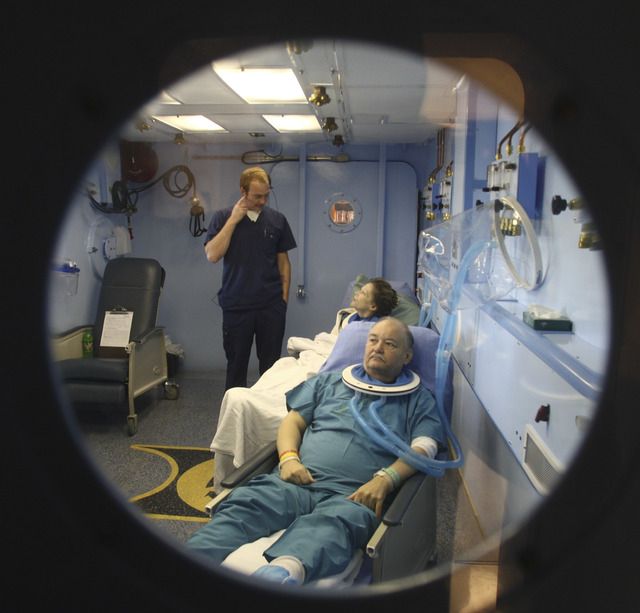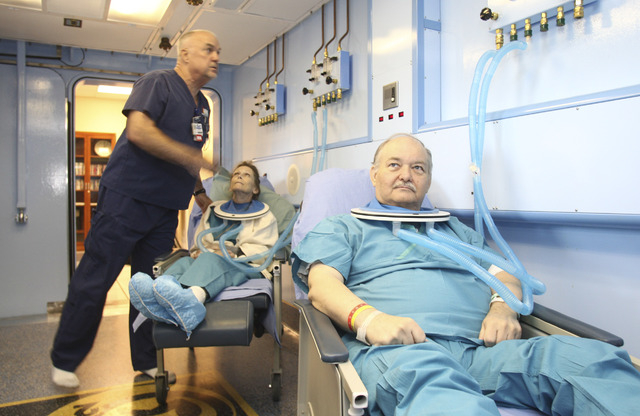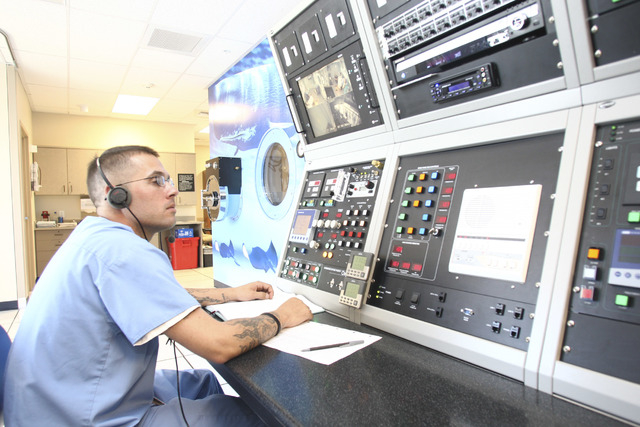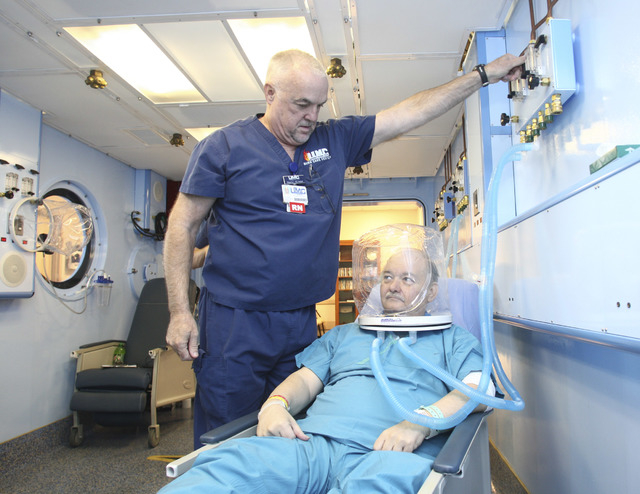UMC might have to give up its life-saving hyperbaric chamber




University Medical Center might end up getting rid of its hyperbaric chamber, which the public hospital says is a money-losing venture.
The chamber, a steel rectangular room, is large enough to hold 12 patients, the biggest in the valley.
It administers pure oxygen to patients in the high-pressure chamber, which can treat a variety of medical problems as the increased oxygen speeds healing. It can treat diabetic wounds, disorders from water diving activities and decompression sickness, among other uses.
A National Park Service diver credits the chamber and its staff with saving his life after an equipment failure in November when he was 120 feet underwater at Lake Mead.
But the chamber, which the hospital leases from California-based Oxyheal, is a money-losing proposition for the public hospital, according to UMC. The hospital loses $250,000 a year through the agreement with the provider, which was set up almost 20 years ago, said Brian Brannman, UMC’s chief executive officer.
The revenue from the chamber goes primarily to Oxyheal Health Group, with UMC carrying the operation’s expenses, he said.
Brannman said he has tried to get a break-even deal with Oxyheal, but it hasn’t happened.
He has one more negotiating session with Oxyheal scheduled for today. If that doesn’t work out, then UMC will terminate the lease, he said.
“We’ve tried to grow the wound business, but it hasn’t worked out,” Brannman said, noting that there are at least seven other hyperbaric chambers in Las Vegas used for wound healing.
Those are all for single patients, unlike UMC’s operation. The larger chamber makes it easier for medical staff to work with patients in critical situations. The chamber at UMC isn’t used to treat burns.
Brannman stressed the need to cover the basic health service needs.
“We have to be careful we don’t get too far out on what we offer in care,” he said. “We have basic health care services we have to cover.”
W.T. “Ted” Gurnee, president and chief executive officer of Oxyheal, disagrees with the assertion that the arrangement loses the hospital money. But he stressed that he is committed to negotiating an agreement that keeps the company’s service at the hospital. Oxyheal employees staff the operation.
“UMC is a very important customer. We’ve invested 20 years of our lives there; we don’t want to leave if we don’t have to,” Gurnee said.
He added: “My goal is to go there and try to present a way that both parties can win.”
The equipment will leave UMC and go to another client if negotiations fail.
The chamber is rarely used for emergency cases, about three times a year, said Gregg Fusto, director of trauma and burn services for UMC.
According to UMC’s figures, 169 patients were treated in the chamber last year. Oxyheal’s figures show the equipment is used about 550 times a year.
Fusto noted that even if the service leaves UMC, there will be other options in the valley, in the smaller, one-person tubes.
In those tubes, the patient lies prone during the treatment. In the larger 12-person chamber, there is room for a patient to sit in a chair with medical staff on hand. It’s rare for the chamber to be filled with 12 people, though.
The small chambers don’t necessarily have as much flexibility. At The Valley Health System, there are two chambers each in Valley, Desert Springs and Summerlin hospitals, said Gretchen Papez, a hospital spokeswoman.
Those are for outpatient services, though, and couldn’t treat a diving-related problem such as the bends, she said.
Officials at Lake Mead are keeping an eye on the situation.
Bryan Moore, park dive officer at the Lake Mead National Recreation Area, said going to UMC for a diving-related accident is part of his team’s emergency plan.
Lake Mead’s team has about 100 dives a year, and does larger training events for other National Park Service divers.
If the equipment at UMC went away, he said, they will need to retool the emergency plan and determine whether there is a suitable alternative locally or whether a trip to a Los Angeles or Phoenix hospital would be necessary.
Dave Conlin, a Denver-based National Park Service diver, was training at 120 feet deep in Lake Mead in November. When his equipment failed, he had a seizure and lost consciousness.
He was whisked to UMC. After the treatment, he made a full recovery and returned to diving.
“Because of what they did, I have no aftereffects at all,” Conlin said. “I should have died.”
Conlin, adding that he is speaking as a diver, not on behalf of the Park Service, said he hopes the chamber remains available.
“It is lifesaving,” he said.
Contact reporter Paul Harasim at pharasim@reviewjournal.com or 702-387-2908. Contact reporter Ben Botkin at bbotkin@ reviewjournal.com or 702-405-9781. Follow him on Twitter @BenBotkin1.











